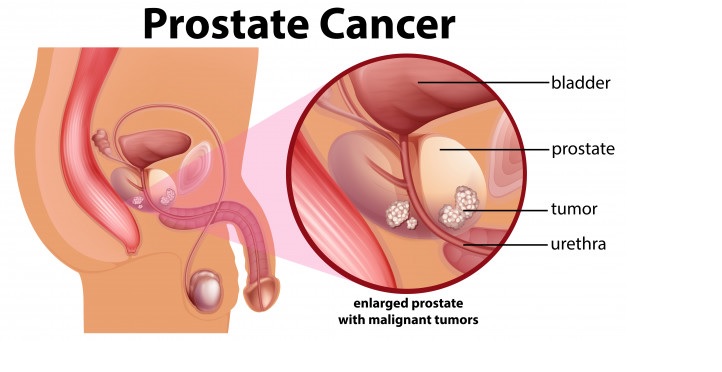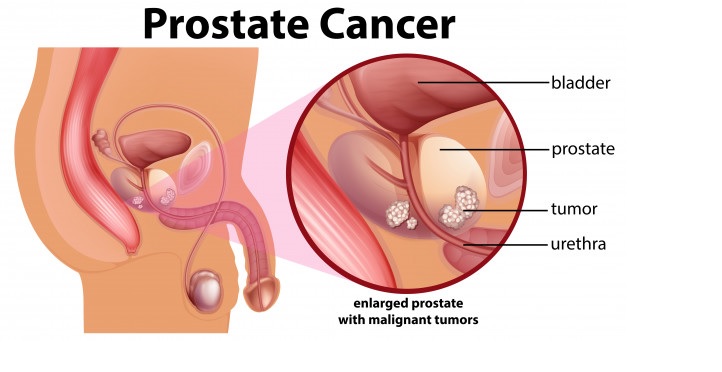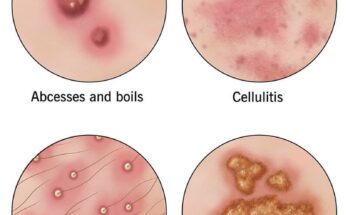Prostate cancer is one of the most common cancers affecting men worldwide, yet many are unaware of its risk factors, symptoms, and treatment options. As men age, maintaining prostate health becomes increasingly important, especially since prostate problems can range from benign conditions to more serious concerns like cancer.
Overview
What is the Prostate?

The prostate is a small, walnut-sized gland located just below the bladder in men. It plays an essential role in the male reproductive system, producing seminal fluid that nourishes and transports sperm. While the prostate is vital for fertility, it’s also a site where various health problems can arise, most notably prostate cancer.
Types of Prostate Problems
- Benign Prostatic Hyperplasia (BPH): This is a non-cancerous enlargement of the prostate that often occurs as men age. While not life-threatening, BPH can cause urinary problems such as frequent urination, weak urine flow, and incomplete bladder emptying.
- Prostatitis: This refers to the inflammation of the prostate gland, which may result from infection or other factors. It can lead to pelvic pain, difficulty urinating, and pain during ejaculation.
- Prostate Cancer: A malignant growth within the prostate gland, prostate cancer is the most serious of the prostate-related conditions. It’s important to note that not all prostate issues are cancerous, but cancer is a significant health concern.
How Common is Prostate Cancer?
Prostate cancer is one of the most common types of cancer in men, particularly in older men. In fact, it is the second most diagnosed cancer globally, following skin cancer. In the United States alone, it is estimated that 1 in 8 men will be diagnosed with prostate cancer during their lifetime.
Prostate cancer is more common in men over the age of 50, and the risk increases with age. African American men and men with a family history of prostate cancer also face a higher risk.
Symptoms and Causes
Symptoms and Causes of Prostate Cancer
Many early-stage prostate cancers do not present noticeable symptoms, which is why screening and regular check-ups are essential. However, when symptoms do occur, they may include:
- Difficulty starting or stopping urination
- Weak or interrupted urine flow
- Frequent urination, especially at night
- Blood in the urine or semen
- Painful ejaculation
- Persistent pain in the back, hips, or pelvis (in more advanced cases)
The exact cause of prostate cancer remains unclear, but it is believed to be linked to a combination of genetic, environmental, and lifestyle factors. Men with a family history of prostate cancer are at higher risk, as are those with certain gene mutations, like BRCA1 and BRCA2.
Are Prostate Problems Always a Sign of Prostate Cancer?
No, not all prostate issues are indicative of cancer. As mentioned, conditions like Benign Prostatic Hyperplasia (BPH) and prostatitis are common, particularly as men age, but these are not cancerous. It’s essential to distinguish between these benign conditions and cancer to avoid unnecessary anxiety and undergo appropriate treatment.
Risk Factors for Prostate Cancer
Several factors may increase the risk of developing prostate cancer, including:
- Age: The risk increases significantly after the age of 50.
- Family History: Having a father or brother diagnosed with prostate cancer doubles a man’s risk.
- Race/Ethnicity: African American men are at higher risk than men of other races, while Asian and Hispanic men have a lower risk.
- Diet and Lifestyle: A diet high in red meat and low in vegetables may increase risk. Obesity and lack of physical activity are also contributing factors.
- Genetic Factors: Inherited gene mutations, such as BRCA1 and BRCA2, can increase prostate cancer risk.
Diagnosis and Tests
Diagnosis and Tests for Prostate Cancer
When a doctor suspects prostate cancer, several diagnostic tests are used to confirm the diagnosis:
- Digital Rectal Exam (DRE): The doctor feels the prostate gland through the rectum to check for irregularities.
- Prostate-Specific Antigen (PSA) Test: This blood test measures levels of PSA, a protein produced by the prostate. Elevated PSA levels can suggest prostate cancer, but other conditions like BPH or prostatitis can also cause elevated levels.
- Biopsy: If there is suspicion of cancer based on DRE and PSA results, a biopsy is performed to take tissue samples from the prostate and check for cancer cells.
- Imaging Tests: MRI or ultrasound may be used to assess the size and location of tumors.
Screening for Prostate Cancer
Prostate cancer screening is typically recommended for men over 50, or earlier if they are at high risk. The PSA test and DRE are commonly used to screen for prostate cancer. However, screening is a topic of debate among doctors, as not all prostate cancers require immediate treatment. In some cases, prostate cancer grows very slowly and may not be life-threatening, so overdiagnosis and overtreatment can occur.
Grades and Stages of Prostate Cancer
Once diagnosed, prostate cancer is classified based on its grade and stage:
- Grade: The Gleason Score is used to grade prostate cancer based on the pattern of cancer cells. A score of 6 or lower is considered low-grade, while a score of 8 or higher indicates a more aggressive cancer.
- Stage: Staging refers to how far the cancer has spread. Early-stage prostate cancer may be confined to the prostate, while more advanced stages can spread to nearby lymph nodes, bones, or other organs.
Management and Treatment Options for Prostate Cancer
The treatment plan for prostate cancer depends on the stage and grade of the cancer, as well as the patient’s overall health and personal preferences. Common treatments include:
- Active Surveillance: For low-risk, slow-growing cancers, doctors may monitor the cancer closely without immediate treatment.
- Surgery: A prostatectomy involves removing the prostate gland and possibly surrounding tissues if the cancer is localized.
- Radiation Therapy: High-energy radiation is used to target and destroy cancer cells.
- Hormone Therapy: This treatment reduces the level of male hormones (androgens) that fuel the growth of prostate cancer.
- Chemotherapy: Used in advanced prostate cancer to kill rapidly dividing cancer cells.
- Immunotherapy: Boosts the body’s immune system to fight cancer cells.
- Targeted Therapy: Aims at specific molecules involved in cancer growth.
Stem Cell Treatment for Prostate Cancer
Stem cell therapy is an emerging area of treatment for various cancers, including prostate cancer. Stem cells have the potential to regenerate healthy tissue, repair damage, and even fight cancerous cells. One such innovative treatment option is Prosclick, a cutting-edge stem cell therapy designed to target prostate cancer cells while preserving surrounding healthy tissue.

Prosclick is a promising treatment that uses a patient’s own stem cells to encourage natural healing and inhibit the growth of cancerous cells in the prostate. This treatment may offer fewer side effects compared to traditional therapies like chemotherapy and radiation. Early clinical studies have shown positive results, suggesting that Prosclick could be an effective complementary treatment for men with localized or advanced prostate cancer.
Conclusion
Prostate health is crucial for every man, especially as they age. While prostate cancer is a major concern, it’s important to remember that not all prostate problems are cancerous. Regular screenings, awareness of symptoms, and understanding risk factors can significantly aid in early detection and treatment.
With the development of innovative therapies like Prosclick, the future of prostate cancer treatment is more hopeful than ever. Stem cell treatments hold promise in providing new ways to manage and potentially even cure prostate cancer, making it an exciting area of research for the medical community.
If you’re concerned about your prostate health or have been diagnosed with prostate cancer, talk to your doctor about the best treatment options, including the latest advancements in stem cell therapy. Prostate health should never be overlooked, and with the right care, many men can manage or overcome prostate cancer.



